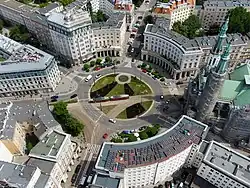Saviour Square
The Saviour Square[lower-alpha 1] is a circular city square and roundabout in central Warsaw, Poland. It is located in the district of Śródmieście (Downtown), in the neighbourhood of Śródmieście Południowe (South Downtown).
Saviour Square | |
|---|---|
| Square | |
 Aerial photograph, 2022 | |
| Opening date | 1768 |
| Location | Śródmieście, Warsaw, Poland |
The square was originally designed by 18th-century gardener and architect Johann Christian Schuch as part of the royal gardens.
Located toward the south end of Marszałkowska Street, near the Royal Baths Park, the square is named after the Church of the Holiest Saviour, which was built in 1901–27 and stands at the square's southern side. Following the Second World War, new colonnades were erected based on those at Piazza della Repubblica in Rome.[1]
The square is intersected radially by three streets: Marszałkowska, Mokotowska and Nowowiejska–Aleja Wyzwolenia. Its center is a roundabout encircled by a ring of buildings containing shops, offices and residences, as well as the church.
The square was the setting and primary filming location for Krzysztof Krauze's 2006 film, Plac Zbawiciela.[2]
The artistic installation Tęcza was installed here in summer 2012 which has been the subject of some controversy. In August 2015 the artistic installation was removed.[3]
Notes
- Polish: Plac Zbawiciela, pronunciation: [plat͡s zbavit͡siɛla]
References
- "Warszawa: Modny Plac Zbawiciela, orientalne restauracje i wielkie zakupy". podroze.se.pl.
- "FilmPolski.pl". FilmPolski (in Polish). Retrieved 2022-06-23.
- "Warsaw's Controversial Rainbow Statue to Be Removed". Time. Retrieved 2022-06-23.
External links
 Media related to Plac Zbawiciela (Warsaw) at Wikimedia Commons
Media related to Plac Zbawiciela (Warsaw) at Wikimedia Commons- Plac Zbawiciela at the official website of Śródmieście district
- Aerial photo from maps.google.com